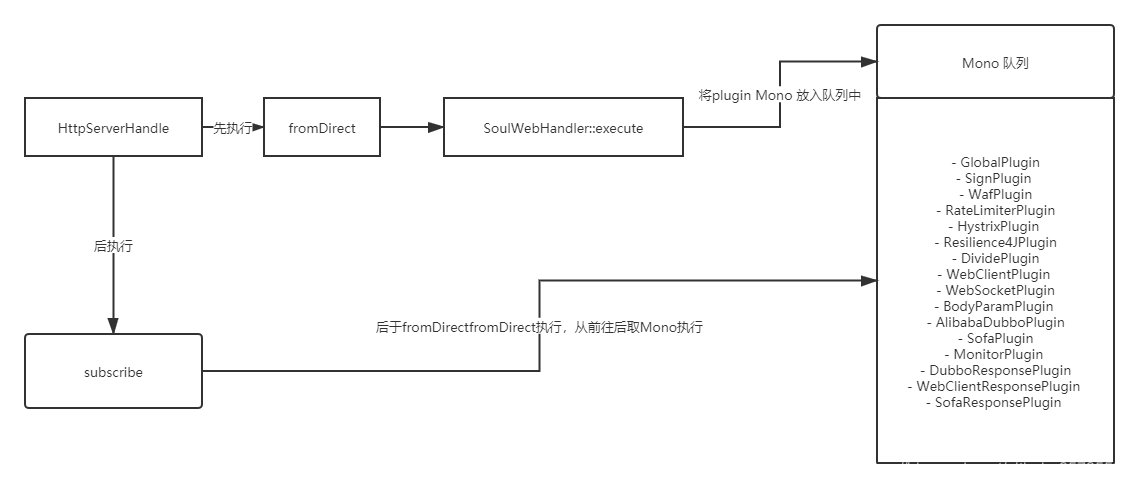Soul 网关源码阅读(七)限流插件初探
简介
前面的文章中对处理流程探索的差不多了,今天来探索下限流插件:resilience4j
示例运行
环境配置
启动下 MySQL 和 redis
docker run -dit --name redis -p 6379:6379 redisdocker run --name mysql -p 3306:3306 -e MYSQL_ROOT_PASSWORD=123456 -d mysql:latest
复制代码
Soul-Admin 启动及相关配置
运行 Soul-admin,进入管理界面:系统管理 --> 插件管理 --> resilience4j ,点击编辑,把它开启
进入管理界面的插件列表:resilience4j 添加选择器和规则,这里安装 divide 插件的匹配方式配的,让 divide 的/http 前缀的接口都走限流(因为使用测试时官方本身自带的 HTTP 测试)
规则配置中:token filling number 要设置大于 0,不然会报错
circuit enable 要设置为 0,判断的时候走限流的逻辑
其他的:fallback uri 随便填个路径,其他的参数都可填 1
Soul-Bootstrap 配置启动
在 Soul-Bootstrap 中进入相关的依赖,大致如下:
<!-- soul resilience4j plugin start--> <dependency> <groupId>org.dromara</groupId> <artifactId>soul-spring-boot-starter-plugin-resilience4j</artifactId> <version>${last.version}</version> </dependency> <!-- soul resilience4j plugin end-->
复制代码
启动 Soul-Bootstrap
HTTP 示例启动
启动:soul-examples --> soul-examples-http --> SoulTestHttpApplication
进入管理界面的:插件列表 --> divide 能看到相关的注册接口信息
访问: http://127.0.0.1:9195/http/order/findById?id=1111
成功运行,下面开始源码 debug
{ "id": "1111", "name": "hello world findById"}
复制代码
源码 Debug
限流流程顺序跟踪确认
根据前面的文章,对处理流程基本上有个清晰的认识了,我们通过前面的调试,知道 RateLimiterPlugin 是继承 AbstractSoulPlugin ,那它就会走和路由匹配相关的逻辑,如下面对代码所示。匹配成功后才走 doExcute 限流逻辑
# AbstractSoulPlugin // 首先进行路由匹配 public Mono<Void> execute(final ServerWebExchange exchange, final SoulPluginChain chain) { String pluginName = named(); final PluginData pluginData = BaseDataCache.getInstance().obtainPluginData(pluginName); if (pluginData != null && pluginData.getEnabled()) { final Collection<SelectorData> selectors = BaseDataCache.getInstance().obtainSelectorData(pluginName); if (CollectionUtils.isEmpty(selectors)) { return CheckUtils.checkSelector(pluginName, exchange, chain); } final SelectorData selectorData = matchSelector(exchange, selectors); if (Objects.isNull(selectorData)) { if (PluginEnum.WAF.getName().equals(pluginName)) { return doExecute(exchange, chain, null, null); } return CheckUtils.checkSelector(pluginName, exchange, chain); } if (selectorData.getLoged()) { log.info("{} selector success match , selector name :{}", pluginName, selectorData.getName()); } final List<RuleData> rules = BaseDataCache.getInstance().obtainRuleData(selectorData.getId()); if (CollectionUtils.isEmpty(rules)) { if (PluginEnum.WAF.getName().equals(pluginName)) { return doExecute(exchange, chain, null, null); } return CheckUtils.checkRule(pluginName, exchange, chain); } RuleData rule; if (selectorData.getType() == SelectorTypeEnum.FULL_FLOW.getCode()) { //get last rule = rules.get(rules.size() - 1); } else { rule = matchRule(exchange, rules); } if (Objects.isNull(rule)) { return CheckUtils.checkRule(pluginName, exchange, chain); } if (rule.getLoged()) { log.info("{} rule success match ,rule name :{}", pluginName, rule.getName()); } return doExecute(exchange, chain, selectorData, rule); } return chain.execute(exchange); }
# RateLimiterPlugin // 匹配完成后走限流的逻辑 protected Mono<Void> doExecute(final ServerWebExchange exchange, final SoulPluginChain chain, final SelectorData selector, final RuleData rule) { final SoulContext soulContext = exchange.getAttribute(Constants.CONTEXT); assert soulContext != null; // 这里更加字符串转成对象,所有规则哪里不能乱填 Resilience4JHandle resilience4JHandle = GsonUtils.getGson().fromJson(rule.getHandle(), Resilience4JHandle.class); // 这里判断 Circle enable 是否为1 走 combined的逻辑,但我们这次想走 limit 的逻辑,所以要填0 if (resilience4JHandle.getCircuitEnable() == 1) { return combined(exchange, chain, rule); } return rateLimiter(exchange, chain, rule); }
// 到这有些复杂,看的不是太懂,只能继续跟下去 private Mono<Void> rateLimiter(final ServerWebExchange exchange, final SoulPluginChain chain, final RuleData rule) { return ratelimiterExecutor.run( chain.execute(exchange), fallback(ratelimiterExecutor, exchange, null), Resilience4JBuilder.build(rule)) .onErrorResume(throwable -> ratelimiterExecutor.withoutFallback(exchange, throwable)); }
复制代码
plugin 前面代码还是看的懂,但 rateLimiter 开始就有些迷糊,流式编程的知识用上都看不懂了,但大致知道是进行限流逻辑
public class RateLimiterExecutor implements Executor {
@Override public <T> Mono<T> run(final Mono<T> toRun, final Function<Throwable, Mono<T>> fallback, final Resilience4JConf conf) { // 生成限流器 RateLimiter rateLimiter = Resilience4JRegistryFactory.rateLimiter(conf.getId(), conf.getRateLimiterConfig()); // 应该是在这触发的限流逻辑 Mono<T> to = toRun.transformDeferred(RateLimiterOperator.of(rateLimiter)); if (fallback != null) { return to.onErrorResume(fallback); } return to; }}
复制代码
继续跟到上面那个类,我们看到了明显的生成限流器的逻辑,但有个让疑惑的是,因为返回的 Mono,但没有看到明显的限流触发逻辑。在没有响应式编程的基础的时候感觉很懵,目前也没去定位真正的触发代码是在哪?但猜测是在上面注释中标注的那段触发的
因为响应式,没有办法跟下去了,我们只能另找路径,看看具体的限流逻辑是什么样的
通过上面知道:RateLimiter 是限流器,我们查看它的具体实现
发现是一个接口,我们看看它有哪些实现,发现有两个: SemaphoreBasedRateLimiter 和 AtomicRateLimiter
因为不知道用的哪个,我们在这两个类中可能会执行的函数都给打上断点
重启发送请求,不断的跳断点,终于进入了一个限流器的类: AtomicRateLimiter ,大致如下
# AtomicRateLimiter public long reservePermission(final int permits) { long timeoutInNanos = ((AtomicRateLimiter.State)this.state.get()).config.getTimeoutDuration().toNanos(); AtomicRateLimiter.State modifiedState = this.updateStateWithBackOff(permits, timeoutInNanos); boolean canAcquireImmediately = modifiedState.nanosToWait <= 0L; if (canAcquireImmediately) { this.publishRateLimiterEvent(true, permits); return 0L; } else { boolean canAcquireInTime = timeoutInNanos >= modifiedState.nanosToWait; if (canAcquireInTime) { this.publishRateLimiterEvent(true, permits); return modifiedState.nanosToWait; } else { this.publishRateLimiterEvent(false, permits); return -1L; } } }
复制代码
具体实现逻辑,不是我们此次关注的目的,此次是想看它在 plugin 中处理的流程顺序如何
和前面几篇一样,我们在: SoulWebHandler 打上断点,看看限流器的执行顺序是什么样的
通过 debug,我们发现顺序和我们预期的基本一致:在进入 RateLimiterPlugin 插件执行的时候,执行的断点也到了限流器(AtomicRateLimiter),等限流器逻辑执行完毕,divide 等插件才开始执行
关于执行处罚和 Mono 的一些思考
我们看一下下面限流执行的代码:
public class RateLimiterExecutor implements Executor {
@Override public <T> Mono<T> run(final Mono<T> toRun, final Function<Throwable, Mono<T>> fallback, final Resilience4JConf conf) { // 生成限流器 RateLimiter rateLimiter = Resilience4JRegistryFactory.rateLimiter(conf.getId(), conf.getRateLimiterConfig()); // 应该是在这触发的限流逻辑 Mono<T> to = toRun.transformDeferred(RateLimiterOperator.of(rateLimiter)); if (fallback != null) { return to.onErrorResume(fallback); } return to; }}
复制代码
返回的一个 Mono
我们再看看 divide 之类的,也是返回的 Mono
public class DividePlugin extends AbstractSoulPlugin {
@Override protected Mono<Void> doExecute(final ServerWebExchange exchange, final SoulPluginChain chain, final SelectorData selector, final RuleData rule) { final SoulContext soulContext = exchange.getAttribute(Constants.CONTEXT); assert soulContext != null; final DivideRuleHandle ruleHandle = GsonUtils.getInstance().fromJson(rule.getHandle(), DivideRuleHandle.class); final List<DivideUpstream> upstreamList = UpstreamCacheManager.getInstance().findUpstreamListBySelectorId(selector.getId()); if (CollectionUtils.isEmpty(upstreamList)) { log.error("divide upstream configuration error: {}", rule.toString()); Object error = SoulResultWrap.error(SoulResultEnum.CANNOT_FIND_URL.getCode(), SoulResultEnum.CANNOT_FIND_URL.getMsg(), null); return WebFluxResultUtils.result(exchange, error); } final String ip = Objects.requireNonNull(exchange.getRequest().getRemoteAddress()).getAddress().getHostAddress(); DivideUpstream divideUpstream = LoadBalanceUtils.selector(upstreamList, ruleHandle.getLoadBalance(), ip); if (Objects.isNull(divideUpstream)) { log.error("divide has no upstream"); Object error = SoulResultWrap.error(SoulResultEnum.CANNOT_FIND_URL.getCode(), SoulResultEnum.CANNOT_FIND_URL.getMsg(), null); return WebFluxResultUtils.result(exchange, error); } // set the http url String domain = buildDomain(divideUpstream); String realURL = buildRealURL(domain, soulContext, exchange); exchange.getAttributes().put(Constants.HTTP_URL, realURL); // set the http timeout exchange.getAttributes().put(Constants.HTTP_TIME_OUT, ruleHandle.getTimeout()); exchange.getAttributes().put(Constants.HTTP_RETRY, ruleHandle.getRetry()); return chain.execute(exchange); }}
复制代码
再看看我们非常熟悉: SoulWebHandler
public Mono<Void> execute(final ServerWebExchange exchange) { return Mono.defer(() -> { if (this.index < plugins.size()) { SoulPlugin plugin = plugins.get(this.index++); Boolean skip = plugin.skip(exchange); if (skip) { return this.execute(exchange); } return plugin.execute(exchange, this); } return Mono.empty(); }); }
复制代码
在上面函数中,通过英文,可以看到所有的 Plugin 都是返回一个 Mono
我们结合响应式编程的相关概念:发布订阅。也就是说,这些 plugin Mono 会发布到一个队列中,当订阅的时候,就会取出来顺序执行
订阅的逻辑大致在那呢,我们翻一翻我们第三篇分析:Soul 网关源码阅读(三)请求处理概览
在类:HttpServerHandle ,找到很可疑的一段,猜测应该是这:
public void onStateChange(Connection connection, State newState) { if (newState == HttpServerState.REQUEST_RECEIVED) { try { if (log.isDebugEnabled()) { log.debug(ReactorNetty.format(connection.channel(), "Handler is being applied: {}"), new Object[]{this.handler}); }
HttpServerOperations ops = (HttpServerOperations)connection; // 在这进行了发布和订阅,而handler.apply(ops, ops)会不断调用后面哪些plugin的逻辑 Mono.fromDirect((Publisher)this.handler.apply(ops, ops)).subscribe(ops.disposeSubscriber()); } catch (Throwable var4) { log.error(ReactorNetty.format(connection.channel(), ""), var4); connection.channel().close(); } }
}
复制代码
而限流的 Mono 是在 divide 之前,所以限流就先执行了,大致示意图如下:
大意是:fromDirect 函数触发将 Plugin Mono 放到队列中;subscribe 函数,触发执行,执行顺序先进先出,则 GlobalPlugin 先进去的,则先开始执行(图中 Global 先进的,把上方看做队列底部,理解意思就行)。那顺序就对应上了我们的调试猜想
还没深入研究响应式编程,所以也有可能是错的
疑问点
在下面这段生成限流器的逻辑中,好像每次请求过来都是进行一个新的生成,有没有可能进行复用,配置里面加一个字段,表示是否更新过,没有更新,我们就复用我们之前的限流器;有更新我们就新生成一个
当然上面优化,需要在具体了解动态配置更新后,再看看是否可行
也有可能是不熟悉 Resilience4J,可能下面的代码中 Resilience4JRegistryFactory 本身实现了缓存复用
public class RateLimiterExecutor implements Executor {
@Override public <T> Mono<T> run(final Mono<T> toRun, final Function<Throwable, Mono<T>> fallback, final Resilience4JConf conf) { // 生成限流器 RateLimiter rateLimiter = Resilience4JRegistryFactory.rateLimiter(conf.getId(), conf.getRateLimiterConfig()); // 应该是在这触发的限流逻辑 Mono<T> to = toRun.transformDeferred(RateLimiterOperator.of(rateLimiter)); if (fallback != null) { return to.onErrorResume(fallback); } return to; }}
复制代码
总结
本次文章大致探索了限流插件:resilience4j 的使用配置。调试验证它的限流逻辑执行在 plugin 链中执行顺序,发现基本符合我们的猜想,限流逻辑的执行和 plugin 顺序一致
还初步讨论提出了 plugin 链在 Mono 队列中的执行猜想,后面研究响应式编程的时候验证一下猜想是否正常
最后提出了一些对限流器生成的一些优化疑问,看后面配置更新相关的分析的时候,是否能验证自己的猜想
参考链接
Soul 网关源码分析文章列表
Github
掘金













评论